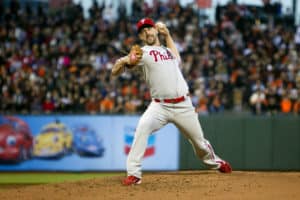

Cliff Lee returned to the Phillies in 2011. (John Hefti/Icon Sportswire)
Given the nature of the contract that the Philadelphia Phillies signed Bryce Harper to in March – 13 years/$330 million – his deal is unquestionably the most important signing in franchise history, whether it turns out to be successful, unsuccessful or somewhere in between. And the reaction to his signing may very well have been the most excited Phillies fans have ever been about a transaction, though the signing of Cliff Lee ahead of the 2011 season is at least in the discussion.
As it turns out, the jubilation surrounding the signing of both stars isn’t the only common thread between the two.
After general manager Ruben Amaro Jr. acquired Lee from the Cleveland Indians ahead the July 2009 non-waiver trade deadline, Lee became a playoff hero. In five postseason starts in 2009, Lee went 4-0 with a 1.56 ERA, including throwing complete games in Game 1 of the NLDS and World Series.
Rather shockingly, the Phillies traded Lee to the Seattle Mariners in December of 2009, just over a month after he dominated the Yankees at Yankee Stadium in the first game of the World Series. The deal wasn’t all negative – it corresponded with the Phillies acquiring future Hall of Famer Roy Halladay from the Toronto Blue Jays – but the package that the Phillies received in return for Lee amounted (no pun intended) to next-to-no major league impact. Lee also had arguably the best season of his career in 2010, and after being traded again to the Texas Rangers that July, he again helped his new team to reach the World Series.
By now, you know how this story concluded. Lee became a free-agent after the 2010 season and spurned larger offers from the Rangers and New York Yankees – Cole Hamels says the Rangers were actually the biggest competitor for Lee’s services – and returned to the Phillies on a five-year/$120 million deal. The Phillies didn’t ultimately win a World Series with Lee, but 2011 was a magical season that saw an all-time great starting rotation lead the Phillies to a franchise-record 102 regular season wins.
Lee didn’t win the National League Cy Young Award in 2011, though that’s only because Halladay – who will be posthumously inducted into the Hall of Fame this August – and Clayton Kershaw – who will be elected to the Hall of Fame five years after his illustrious career wraps up – were even better than him. In a normal year, Lee’s 2011 season may very well have won him the award. In his age-32 season, Lee went 17-6 with a 2.40 ERA, 2.60 FIP and 7.1 fWAR.
But, like Harper in 2019, Lee didn’t get off to a scorching-hot start in 2011. Lee did throw a complete-game shutout at Nationals Park on April 14, so just as Harper had a major early season moment against the Nationals, Lee’s first month back with the Phillies wasn’t without reminder of why his signing brought so much excitement. But at the end of April 2011, Lee was 2-2 with a very pedestrian 4.18 ERA.
In fact, Lee went 2-3 with a 3.78 ERA in *seven* starts in May of 2011. At the end of May, Lee was 4-5 with a 3.94 ERA. Even given his history, there was little evidence through the first two months of the 2011 season that Lee was in the midst of what would turn out to be one of the greatest seasons a Phillies starter has ever turned in.
Granted, Lee’s month of June 2011 remains unfathomable. He went 5-0 with an 0.21 ERA that month, including throwing three consecutive complete game shutouts to end the month. Lee’s month of June 2011 may very well be the best month a Phillie has ever had – be it a pitcher or position player.
Will Harper have a better month this season – or any season – than Lee had in June of 2011? Probably not. But that’s fine, Lee had two below-average months, at least by his standards, to open his first full season in red pinstripes. After setting the world on fire in June, Lee went 1-2 with a 4.91 ERA in July. Lee then followed that back up by turning in dominant months of August and September. At the end of the year, despite having three sub-par months by his standards, Lee’s year was viewed as dominant. Major League Baseball is a marathon, not a sprint.
“I’m not concerned at all,” Kapler said Thursday morning to Angelo Cataldi on SportsRadio 94 WIP. “I mean, obviously, I feel for Bryce because I know that all he wants is to produce for this city. But if you look at the story of his career, he’s had some hot streaks, he’s had some cold streaks. At the end of the year, he’s always one of the most productive offensive players in the league.”
A season ago, Harper hit .214 before the All-Star Break, before slashing .300/.434/.538 with 11 home runs, 46 RBIs and 52 walks after the midsummer classic. He slashed .325/.431/.590 with 20 home runs and 65 RBIs in the first-half of the 2017 season. Harper, a six-time All-Star, is capable of putting together months that, like Lee in 2011, will make a bit of a sluggish start a distant memory.